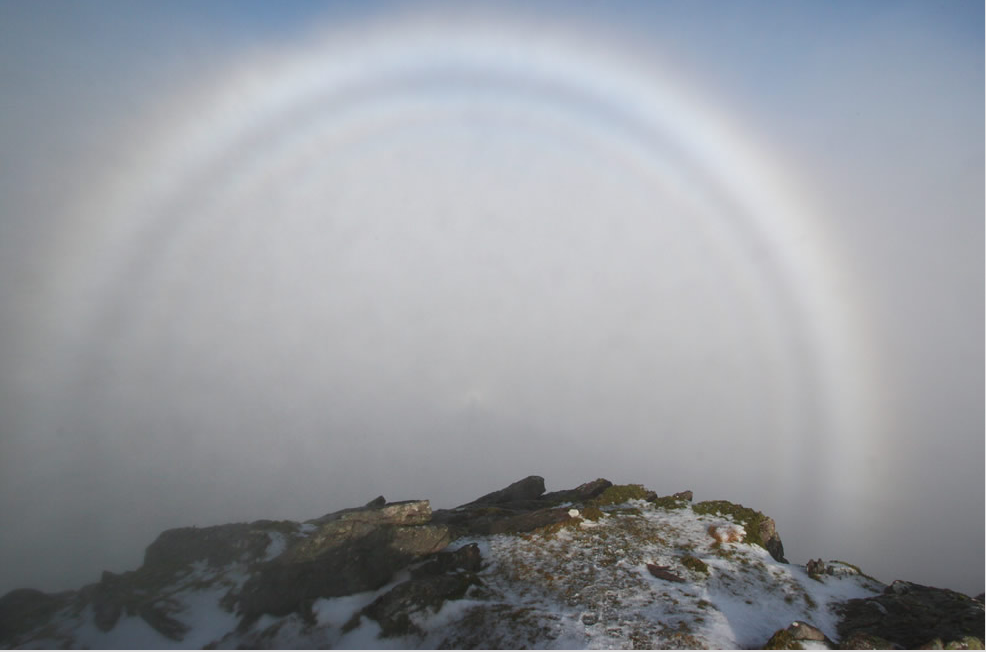McGillycuddy Reeks, Kerry, Ireland fogbow
McGillycuddy Reeks, Kerry, Ireland Fogbow: A Spectacular Atmospheric Phenomenon
Have you ever witnessed a fogbow? If not, you're in for a treat. One particularly memorable fogbow was captured by photographer Aidan Forde in February 2007 at McGillycuddy Reeks, Kerry, Ireland. With its vibrant colors and unique features, this fogbow stands out from the rest. Let's dive into the fascinating details of this atmospheric phenomenon and explore what makes it so special.
The McGillycuddy Reeks and Ideal Conditions
McGillycuddy Reeks, a mountain range in County Kerry, Ireland, is known for its stunning natural beauty. The ridge of the range runs from east to west, creating a unique wind pattern that contributes to the formation of extraordinary fogbows. When the wind blows up the gentle southern slope and creates a vortex in the steep corrie on the northern side, it brings cold air up the northern slope. However, the air only reaches the top and stays on the northern side. These conditions create an ideal environment for the formation of fogbows.
The Captivating Features of Aidan Forde's Fogbow
Aidan Forde's photograph of the fogbow at McGillycuddy Reeks showcases several captivating features. The fogbow itself is accompanied by two supernumeraries, which are additional fainter arcs that appear inside the main bow. This phenomenon occurs when sunlight is diffracted by tiny water droplets in the fog. At the center of the fogbow, there is a tiny glory, which is a colorful ring caused by the diffraction and interference of light. Additionally, Aidan's shadow creates a Brocken spectre, a phenomenon where an observer's shadow is cast onto a cloud or fog bank.
The Role of Optics in Fogbow Formation
To understand how fogbows form, we need to delve into the world of optics. A fogbow is a type of rainbow that occurs when sunlight interacts with water droplets in fog. Unlike rainbows, which are formed by raindrops, fogbows are created by much smaller droplets. These droplets are typically less than 0.1 millimeters in diameter, resulting in a diffraction pattern that produces a white or pale-colored bow. The smaller droplet size also contributes to the absence of vibrant colors typically seen in rainbows.
Exploring the Science Behind Fogbow Colors
The colors of a fogbow are usually less saturated than those of a rainbow. This is because the smaller droplets in fog scatter light more efficiently, resulting in less separation of colors. As a result, fogbows often appear as white or pale arcs, with hints of pastel colors at times. However, under certain conditions, such as when the droplets are larger or there is a greater concentration of droplets, more distinct colors may be visible in the fogbow.
The Enigmatic Glory at the Center of the Fogbow
At the heart of Aidan Forde's fogbow photograph lies a tiny glory. The glory is an optical phenomenon that occurs when sunlight is scattered backwards by water droplets. It appears as a series of concentric rings around the shadow of the observer. The size of the glory depends on the size of the water droplets and the angle at which the sunlight is scattered. In Aidan's photograph, the glory adds an extra touch of magic to an already captivating scene.
Unveiling the Brocken Spectre
Aidan Forde's shadow cast onto the fogbank creates a mesmerizing Brocken spectre. This phenomenon is named after the Brocken, a peak in the Harz Mountains of Germany where it was first observed. A Brocken spectre occurs when an observer stands above a cloud or fog bank, and their shadow is projected onto the mist. The combination of light and shadow creates a magnified and distorted image of the observer, surrounded by a halo-like glow. It is a truly ethereal sight that adds to the allure of Aidan's fogbow photograph.
The Beauty of Atmospheric Optics
The fogbow captured by Aidan Forde at McGillycuddy Reeks, Kerry, Ireland, is a testament to the beauty and wonder of atmospheric optics. It showcases the intricate interplay of sunlight, water droplets, and unique weather conditions. Witnessing such a phenomenon is a rare and awe-inspiring experience that reminds us of the hidden marvels that surround us in the natural world.
Conclusion
Fogbows are a captivating atmospheric phenomenon that adds a touch of magic to the landscape. Aidan Forde's photograph of the fogbow at McGillycuddy Reeks, Kerry, Ireland, with its supernumeraries, glory, and Brocken spectre, exemplifies the enchanting beauty of these optical wonders. The unique wind patterns at McGillycuddy Reeks create ideal conditions for fogbow formation, making it a hotspot for witnessing this breathtaking phenomenon. So keep your eyes peeled the next time you find yourself surrounded by fog – you might just catch a glimpse of nature's own ethereal light show.

McGillycuddy Reeks, Kerry, Ireland. Aidan Forde captured this memorable fogbow with two supernumeraries in February '07. He used a wide-angle 10mm lens on a Canon EOS 20D. At the bow's centre there is a tiny glory and Aidan's shadow makes a Brocken spectre. "That ridge very often has very good bows like these - it runs east-west and the wind blowing up the relatively gentle southern slope creates a vortex in the steep corrie on the northern side. This brings the air up the cold northern slope, but only to the top and staying on the northern side. Ideal conditions!" Image ©Aidan Forde, shown with permission.
Note: this article has been automatically converted from the old site and may not appear as intended. You can find the original article here.
Reference Atmospheric Optics
If you use any of the definitions, information, or data presented on Atmospheric Optics, please copy the link or reference below to properly credit us as the reference source. Thank you!
-
<a href="https://atoptics.co.uk/blog/mcgillycuddy-reeks-kerry-ireland-fogbow/">McGillycuddy Reeks, Kerry, Ireland fogbow</a>
-
"McGillycuddy Reeks, Kerry, Ireland fogbow". Atmospheric Optics. Accessed on December 23, 2024. https://atoptics.co.uk/blog/mcgillycuddy-reeks-kerry-ireland-fogbow/.
-
"McGillycuddy Reeks, Kerry, Ireland fogbow". Atmospheric Optics, https://atoptics.co.uk/blog/mcgillycuddy-reeks-kerry-ireland-fogbow/. Accessed 23 December, 2024
-
McGillycuddy Reeks, Kerry, Ireland fogbow. Atmospheric Optics. Retrieved from https://atoptics.co.uk/blog/mcgillycuddy-reeks-kerry-ireland-fogbow/.